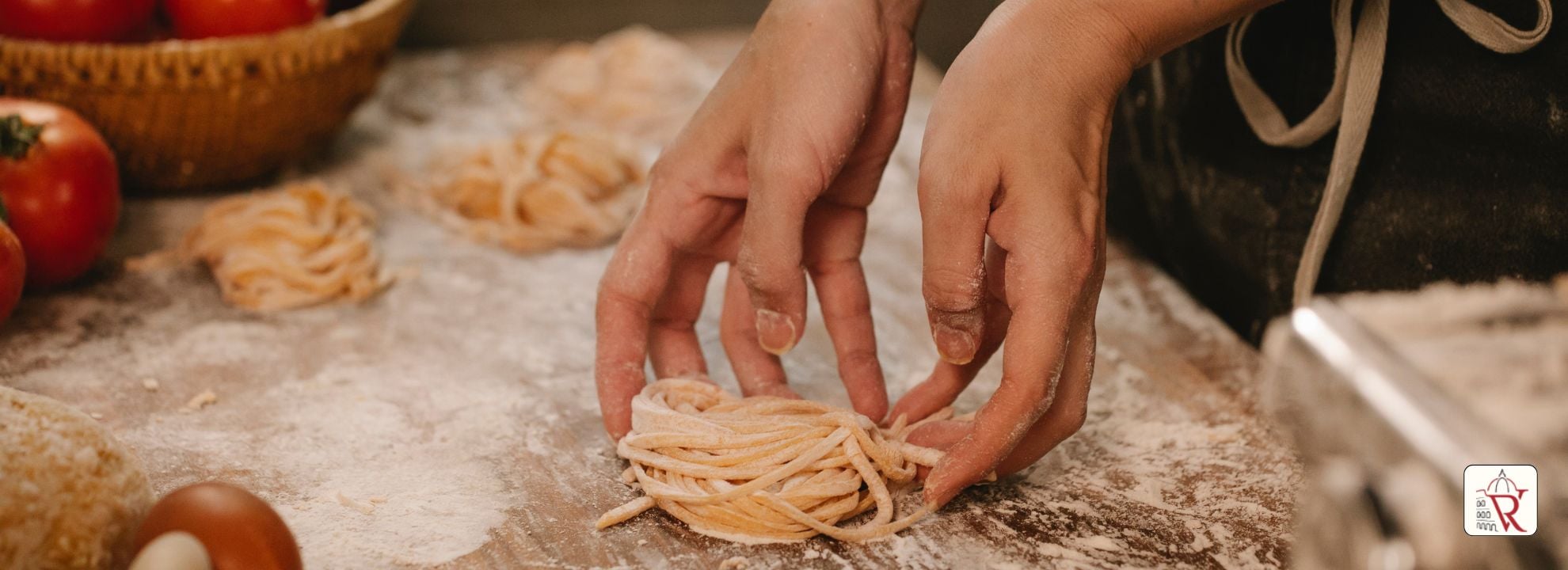Pasta in Rome: traditional dishes, flavors and Roman recipes
- 8 min read
In this guide you will find all the information you need about pasta in Rome, including its history, traditional recipes, dining etiquette, the best neighborhoods to enjoy it, and practical tips to enhance your culinary journey. Whether you are looking for the famous carbonara or hidden trattorias where locals eat, this article will help you discover Rome’s most iconic flavors.


Omnia card 72h + Roma Pass - Jubilee 2025
What is Pasta?
Pasta is one of the cornerstones of Italian cuisine and a culinary symbol of Rome. Traditionally, it is made from a dough of durum wheat, water, and sometimes eggs, which is then shaped into one of more than 600 varieties. Once boiled, pasta is usually paired with sauces, cheeses, vegetables, or cured meats.
The origins of pasta are still debated. Some historians argue that it was inspired by Asian noodles brought through trade routes, while others insist that Romans themselves developed early forms of pasta. Regardless of its roots, pasta in Rome has evolved for centuries, especially after the introduction of tomatoes from the Americas in the 16th century. These ingredients gave birth to the Roman classics that are now known worldwide.

Omnia card 72h + Roma Pass - Jubilee 2025
Why is Rome So Famous for Pasta?
Rome is not only the political and historical heart of Italy but also a gastronomic capital. The city gave birth to some of the world’s most celebrated pasta recipes, such as carbonara, cacio e pepe, and amatriciana. Each dish reflects the region’s agricultural wealth: Lazio is renowned for its high-quality durum wheat, sharp pecorino romano cheese, and guanciale (cured pork cheek).
Above all, the simplicity of Roman pasta highlights the authenticity of local products. For that reason, eating pasta in Rome is not just a meal, it is a cultural experience that connects visitors to centuries of culinary tradition.

Omnia card 72h + Roma Pass - Jubilee 2025
When to Eat Pasta in Rome
Romans usually enjoy pasta at lunch or dinner. Lunch is served between 1:00 p.m. and 3:00 p.m., while dinner is later, typically from 7:00 p.m. to 9:00 p.m. Pasta often appears as the primo piatto (first course), followed by a meat or fish dish.
If you are visiting, it is advisable to book restaurants in the evening, as many trattorias are packed with locals and tourists alike. Pasta in Rome is best enjoyed unrushed, paired with local wines, and in accordance with Italian dining customs.

Omnia card 72h + Roma Pass - Jubilee 2025
Essential Etiquette for Eating Pasta
Eating pasta in Italy comes with its own traditions. To begin with, long pasta like spaghetti should be twirled around the fork against the side of the plate — never cut with a knife. Using a spoon is considered unnecessary.
Additionally, taste the pasta before adding extra cheese. Many recipes, especially those with pecorino romano, are already perfectly seasoned. Finally, remember that pasta portions in restaurants are not usually shared, unlike in a family setting.

Omnia card 72h + Roma Pass - Jubilee 2025
The Famous Four Roman Pastas
When talking about pasta in Rome, it is impossible not to mention the legendary quattro paste romane. These four recipes are the pillars of Roman gastronomy and represent the city’s culinary identity:
- Carbonara: Creamy yet without cream, made with eggs, pecorino romano, guanciale, and black pepper.
- Cacio e Pepe: Minimalist and sharp, created with only pasta, pecorino romano, and black pepper.
- Amatriciana: Rich and flavorful, combining tomato sauce, guanciale, pecorino romano, and chili.
- Gricia: Often called the “mother of Roman pastas,” it uses guanciale, pecorino romano, and pepper, without tomatoes or eggs.
Together, these dishes show how just a few ingredients can be elevated into world-famous recipes. Trying them all is essential for anyone who wants to experience authentic pasta in Rome.
A Special Dish: Pasta with Artichokes and Guanciale
While the four Roman pastas are the most iconic, Rome also celebrates seasonal variations that highlight local produce. One of the most beloved is pasta with artichokes and guanciale.
Artichokes, especially the famous carciofi romani (Roman artichokes), are a staple of the city’s cuisine. They are tender, aromatic, and deeply tied to Roman food culture, often enjoyed as carciofi alla romana (braised) or carciofi alla giudia (fried Jewish-style). When paired with guanciale, their earthy flavor is balanced by the rich, savory taste of cured pork cheek.
This dish is particularly popular in spring, when artichokes are in season. The pasta is usually tossed with sautéed artichokes, crispy guanciale, pecorino romano, and a touch of black pepper. The result is a recipe that feels both rustic and refined, a modern favorite that sits alongside the four Roman classics.

Omnia card 72h + Roma Pass - Jubilee 2025
Roman Recipes: How to Cook Pasta
How to Cook Carbonara: Roman Recipe
To make authentic carbonara, fry guanciale until crispy, cook spaghetti al dente, and mix off the heat with a sauce of eggs and pecorino romano. The result is creamy, rich, and unmistakably Roman. No cream or garlic should ever be used.
How to Cook Amatriciana: Roman Recipe
Amatriciana begins with guanciale sautéed in olive oil, to which peeled tomatoes are added and simmered until thick. Rigatoni or bucatini are the traditional pasta shapes. Once cooked, everything is finished with pecorino romano for a balanced combination of savory, spicy, and tangy flavors.
How to Cook Gricia: Roman Recipe
Often considered the ancestor of carbonara and amatriciana, gricia is prepared by crisping guanciale, then tossing pasta with pecorino romano and black pepper. Without tomatoes or eggs, its strength lies in the perfect emulsion of fat and cheese.
How to Cook Cacio e Pepe: Roman Recipe
This minimalist dish relies on technique. Spaghetti are cooked al dente, then tossed with a creamy emulsion of pecorino romano and freshly ground black pepper. The heat of the pasta water melts the cheese, creating a silky sauce without oil or butter.
How to Cook Pasta with Artichokes and Guanciale: Roman Recipe
Fresh artichokes are cleaned and sliced, then gently stewed in olive oil with garlic. Guanciale is browned until crisp, and the two are combined with pasta (often rigatoni). A final touch of pecorino romano and black pepper brings the dish together, highlighting the flavors of Rome’s seasonal ingredients.

Omnia card 72h + Roma Pass - Jubilee 2025
The Best Neighborhoods in Rome for Pasta
Exploring beyond the major landmarks will reward you with authentic dining experiences.
- Testaccio: Known as the birthplace of Roman cuisine, Testaccio offers traditional trattorias and lively food markets.
- Trastevere: A picturesque neighborhood filled with cobblestone alleys, where family-run restaurants serve some of the city’s most beloved pasta.
- Pigneto: Trendy and bohemian, Pigneto combines traditional flavors with modern interpretations at affordable prices.
- Campo Marzio: Close to the Vatican, this area blends fine dining with elegant streets, ideal for those seeking a refined experience.

Omnia card 72h + Roma Pass - Jubilee 2025
FAQs About Pasta in Rome
What are the typical pasta dishes in Rome?
The most typical are carbonara, cacio e pepe, amatriciana, and gricia, all based on pecorino romano and guanciale.
How is pasta eaten in Italy?
Pasta is served as a first course, eaten with a fork (never a spoon for spaghetti), and enjoyed al dente.
What are the four Roman pasta recipes?
Carbonara, cacio e pepe, amatriciana, and gricia.
What is the name of Rome’s traditional pasta?
There isn’t just one, but spaghetti is most common in Roman recipes.
What pasta shape is typical of Rome?
Spaghetti and rigatoni are the most traditional shapes.
What is the etiquette for eating spaghetti?
Spaghetti should be twirled with a fork against the plate; cutting or using a spoon is not customary.
What traditional food should you try in Rome?
Besides pasta, try Roman-style artichokes, supplì (fried rice balls), and porchetta.
What is Roman gricia?
Gricia is a pasta dish made with guanciale, pecorino romano, and black pepper, often called the “white amatriciana.”
How much pecorino is used in Carbonara?
The amount varies, but typically 40–50 grams per person are used to achieve the creamy texture.
What is the difference between Carbonara and Gricia?
Gricia has no eggs, while carbonara includes eggs to create its creamy sauce.
What is the name of the pasta with guanciale and pecorino?
That is gricia, one of Rome’s oldest recipes.
Why is Gricia called like that?
It is named after Griciano, a town in Lazio, where shepherds prepared it with simple ingredients.
Why is Carbonara called like that?
Its name comes from “carbonari,” coal workers who prepared it as a hearty meal.
Why is Amatriciana called like that?
It originates from Amatrice, a small town in Lazio, which gave the dish its name.

